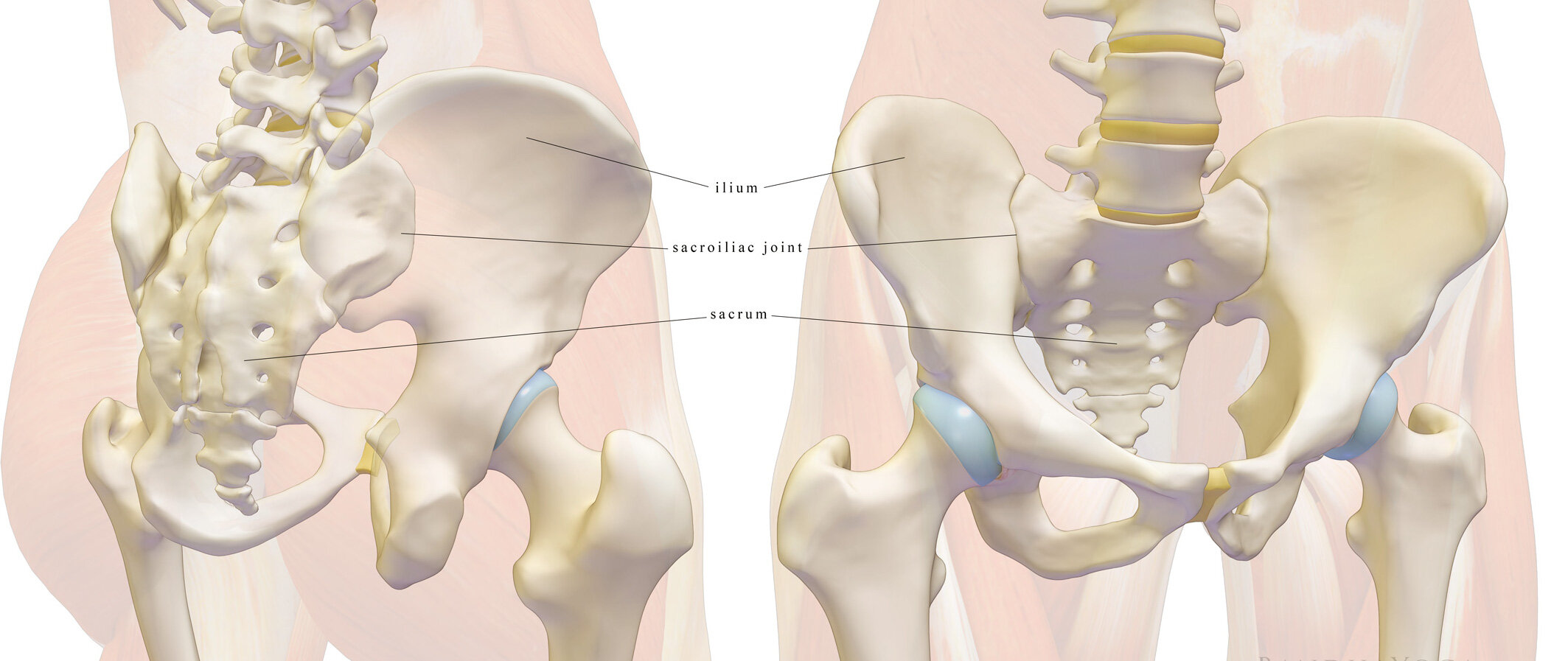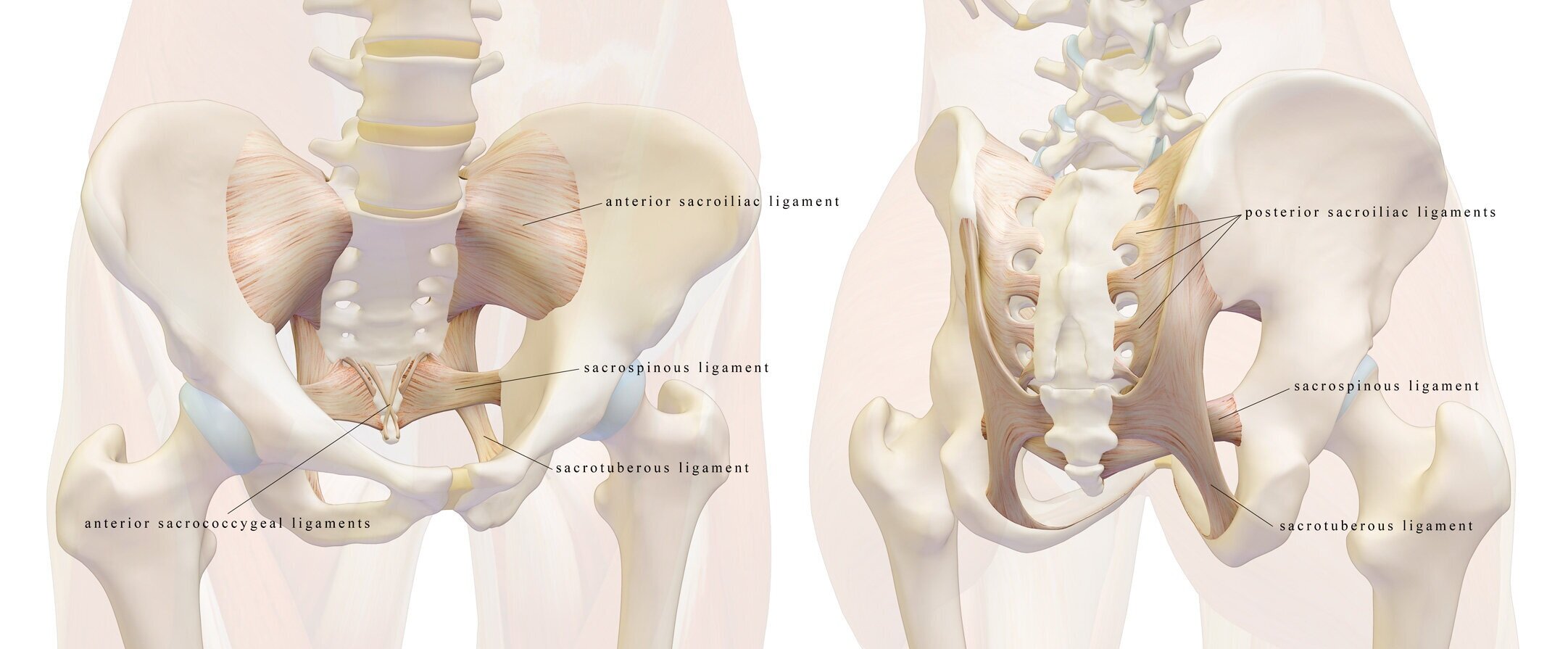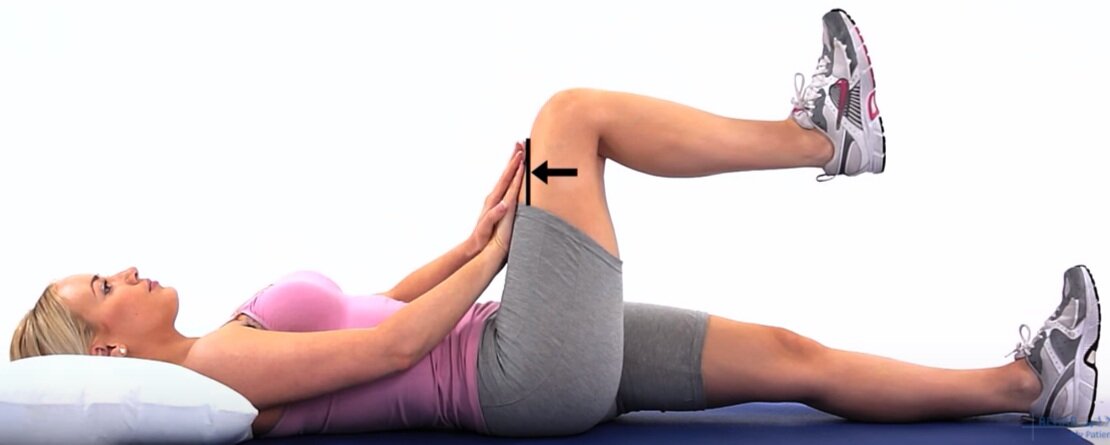Reduce Low Back and Sacroiliac pain with these Toning Exercises
Many people come in complaining of low back pain and point to one or both of their sacroiliac joints. I find a lot of women in particular tend to get discomfort here. There are many factors that can cause it, which I have outlined below. The following exercises will help to stabalise the pelvis and restore balance.
photo:dailybandha.com
The sacroiliac joint, often referred to as the SI joint is involved in the transfer of weight and forces between your upper body and your legs. It helps us remain balanced when we are walking and it also aids in shock absorption.
The sacroiliac joint is located between the ilium and the sacrum, on each side of the pelvis. The sacrum supports the spine and the iliac bones, which look like wings, aide to support the sacrum and create the bowl shaped pelvis.
photo:dailybandha.com
Compared with other joints in the body, there is very little movement in the SI joint as it’s main roll is shock absorption. A very small amount of rotation occurs in this area for activities such as walking, twisting, bending. The sacrum either tilts or tucks with movement. It needs to flex appropriately for giving birth. The irregular and rough joints add to the stability of this joint; they act as interlocking bones which are stabilised and supported by strong ligaments. Like an ankle you can actually sprain an SI joint due to ligamentous strain.
Needless to say sprains and strains to the sacroiliac joint can be hugely inconvenient and can cause a range of pains, not just from the area around the SI joint. Pina can refer to the buttocks, thigh or groin. As a result of postural distortion, one can also experience pain in the knee, foot or even neck and thoracic area as the body compensates due to a strain in these large weight bearing joints.
How would you know if it is your sacroiliac joint that is causing you pain?
Typically SI joint (SIJ) problems can create a variety of symptoms. The following may be an indication that your SI joint may not be functioning properly, leading to postural imbalances and symptoms.
Lower back pain and stiffness
Hip, groin or leg pain
One leg may feel or look shorter due an imbalance of the pelvic muscles
Feelings of leg instability (feeling like your leg may give way). This can be due to muscles that are not firing appropriately
Pain that gets worse when going from standing to sitting or lifting the knee towards the chest as when going up stairs
Pain that is a mild to moderate ache located around the dimple just lateral to the sacrum (posterior superior iliac spine area)
More often than not SI joint pain presents on one side or the other. Often when one joint is restricted the pain occurs in the other joint as well. It is not uncommon for the symptoms to switch to the other side at some point
Pain can be referred from the SI joint down to the gluteus muscles or back of thigh
There may be a different pattern of tightness in one leg in comparison to the other. For example your right leg might feel tight or tender along the inner thigh and gluteus muscles and your left leg might feel tender along the outer thigh.
Why do we get SI joint pain?
SI joint pain can occur for any number of reasons:
Injury such as a fall or whiplash can cause the joint to be sprained. Like an ankle sprain this will take at least 6 weeks to heal after the pelvis has been realigned by a chiropractor.
Trauma to another area of the hips such as the ball and socket joint
A strain or muscular imbalance of the muscles that originate or insert near the pelvis
A compensation pattern that results from a neck or shoulder issue
An abnormal gait or walking pattern such as over-pronation of the foot where one foot rolls in medially.
Signs of uneven wear on the sole on your shoe can identify this problemDay to day stresses on your pelvis such as excessive sitting down, or working in a job that requires wearing a heavy tool belt for many hours
What can I do to relieve my SI joint pain?
Stretches help to rebalance the muscles to rehabilitate a weakened SI joint and prevent re-injury. As with all stretches it's important to remember you should never force a stretch. Listen to your body and if you begin to feel pain you should stop. Take your time and breath through these exercises. They should feel good to do.
Single knee to chest stretch:
This stretch is a nice and gentle one for your SI joint, it is also beneficial for the back and hips.
Lie on your back with your legs extended. Exhale and draw one of your knees to your chest.
Bend your knee up enough so you can grasp your lower leg with both hands. Interlace your fingers just underor over the knee and gently pull your leg towards your trunk, hold for 5- 10 seconds.
Inhale and lower your leg back to the mat. Repeat the process with your other leg. Repeat this process about 8 times on each side.
You should be able to feel your lower back, glutes, hip flexors and hamstring muscles being stretched when you do this exercise.
As in the image keep you head on your mat. You do not want to activate your core or strain your neck. If you are experiencing lower back pain you may find it more comfortable to keep the unengaged leg bent and the foot of that leg flat to the ground.
Isometric Knee Push:
This exercise strengthens the muscles of your buttocks, inturn it will help to improve stability of the SIJ.
Photo:r ehabmypatient
Bring your right knee to 90 degrees and use your upper body strength to press into the top of the thigh while you create an opossing force by press the knee toward your hands and head.
Hold this pose for 5 to 10 seconds while remebering to breathe. Build up to 10 repetitions alternating legs each time.
Modified Bridge:
This pose helps to develop stability in the pelvis and sacrum by strengthening the abdominal muscles, particularly the transverse abdominals.
Lie on your back with your knees bent and your feet hip distance apart with your arms by your side. Keep your neck relaxed throughout the exercise.
As you exhale, lift your hips away from the floor. As you do this, put energy into pushing your knees in the opposite direction of your pelvis. The lower yourself towards the mat. Work up to 8 repetitions of this.
When you are confident with modified briedge, try this:
As you exhale, raise your hips by curling the spine up vertebra by vertebra. To do this begin with the tailbone and moving up the spine sequentially to just above the bra strap.
Lengthen your tailbone away from your head, curl it slightly up toward the ceiling, and lift the hips until you’ve reached a straight line from your shoulder blades to your knees. Do not arch your back or lift your hips higher than a straight line. You are looking to achieve abdominal engagement rather than the backbend version of the pose.
Press into the floor through your heels and the backs of your shoulders and clench your buttock muscles. Then slowly lower to the floor. Repeat this exercise 5-10 times.
Clamshell:
This exercise is great for leg and hip strengthening, and if it isn’t in your workout repertoire it’s worth adding it. As well as strengthening your hip flexors and gluteus muscles, it can help to stabilise your pelvic muscles and tone your glutes. The clamshell can also help to prevent injury and ease lower back tension.
photo: yogainternational.com
Lie on your side, with legs stacked and bend your knees. Strap optional.
Rest your head on your lower arm or pillow. Be sure that your hip bones are stacked straight up, as there is a tendency for the top hip to rock backward.
Pull your abdominals in to engage them by drawing in your belly button, as this will help to stabilize your spine and pelvis.
Keeping your feet touching, raise your upper knee as high as you can without shifting your hips or pelvis. Don’t move your lower leg off the floor.
Take a brief pause and then return your upper leg to the starting position on the ground. Do 15 reps on each side. If you can’t manage that many do not fret, do as many as is comfortable for you.
Bird Dog
This exercise can help to strengthen the dynamic stabilizers of the SI joint. These muscles, along with the fascia comprise the “posterior oblique sling”.
Photo: doyou.com
Begin on your hands and knees with both of your hands positioned under your shoulders and knees positioned under your hips. Look down to ensure your head, neck, and back maintain a neutral alignment to minimize stress on your neck.
Raise your left arm and reach it forwards until it is aligned with your torso; at the same time, kick your right leg backwards until is it aligned with your torso.
Hold this position for 2-3 seconds before slowly returning to the starting position.
Repeat with your right arm and left leg.
Alternate sides for 10 repetitions.
When you are experiencing severe SI joint discomfort there are certain activities that are best avoided.
Excessive twisting activities like vacuuming, sweeping and raking leaves.
Strenuous exercise that stresses this area such as running. To keep this area mobile a gentler activity like walking daily is good for your pelvis.
Sitting with your legs crossed can exacerbate an SI joint issue. This asymmetrical way of positioning your body is a good habit to break as it encourages your body out of alignment.
Exercises that require standing on one leg or involve extreme twists are also best avoided.
Climbing up lots of steps can inflame an SI joint issue and cause pain, so if possible avoid flights of steps until you can do so comfortably.
There is a lot of imformation to digest here. Try these exercises at home to help to ease your SIJ pain. If it does not improve after a week or two, it is ideal to get an assessment as your alignment may be a key factor. There may be a muscle imbalance that cannot be resolved with exercise alone.Be Well,
Sarena
Research resources:
https://journals.lww.com/anesthesia-analgesia- Sacroiliac Joint Pain, A Comprehensive Review
https://www.braceability.com
Photo credits:feelgoodyogavictoria.com, medtronic Inc, health.com, centerpeacekent.com







